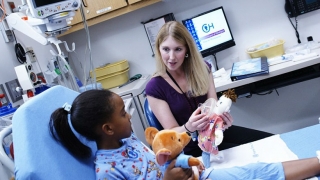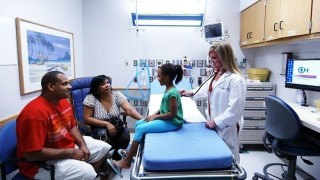About Minimally Invasive Pediatric Surgery
What is minimally invasive surgery?
Minimally invasive surgery (MIS) goes by a lot of names: keyhole surgery, bandaid surgery, scarless surgery, minimal access surgery, general endoscopic surgery, etc. Whatever it is called, minimally invasive surgery is a set of techniques that allow the surgeon to operate through very small incisions using a surgical telescope (a tube containing a camera) and specially-designed instruments.
The pediatric surgeons at Children's Hospital of Philadelphia are experienced in the full range of minimally invasive procedures appropriate for children. In addition to providing laparoscopic, thoracoscopic and endoscopic procedures for children, our surgeons are developing new and innovative minimally invasive procedures specifically designed for the unique surgical problems children face.
During minimally invasive surgery, doctors can use these scopes to take tissue samples, remove foreign bodies and repair damage without making large and painful incisions. While not all conditions are suitable for minimally invasive surgery, it offers several potential benefits:
- Small incisions hurt less
- It is easier to start moving sooner
- The risk of deformity (like scoliosis) is smaller
- Less narcotic medicine is needed
- Hospital stays are shorter, and your child is able to recuperate faster and with less pain
- Small incisions look better, reduce scarring, and have a lower risk of complications (like infection)
- Visualization of anatomy is often much better, providing more information to the surgeon
- Multiple procedures (if needed) can be done through the same set of incisions instead of making two larger incisions, or one even larger incision
CHOP has state of the art minimally invasive surgery capability. The Operating Room complex at the Main Campus is equipped with 23 high-definition MIS “suites,” each of which is stocked with devices specially selected for use in infants and children. The surgical instruments are constantly maintained by technicians who work at CHOP full time. The nurses have undergone specialized training as well. The surgeons have extensive experience with these techniques, particularly with the modifications of the methods required to expertly apply them in babies and children.
Watch the video below to learn more about CHOP's minimally invasive surgery capabilities.
A minimally invasive approach is not always the right choice for your child. Some children have anatomy or physiology that is not conducive to these methods. On the other hand, previous conventional surgery is not necessarily a contraindication to using minimally invasive surgery. Regardless of the circumstance, CHOP’s MIS capability broadens the available options, so that the operation can better fit your child’s particular needs. Your surgeon can explain more.
Minimally invasive procedures
The Operating Room complex at the Children's Hospital of Philadelphia Main Campus has 23 suites specially equipped for minimally invasive procedures, with dedicated support staff and highly trained nurses. This allows us to offer a very broad range of minimally invasive laparoscopic and thoracoscopic operations.
When MIS is done in the abdomen, it is called laparoscopy. In the chest, the method is called thoracoscopy. This is why fundoplication (for reflux disease) may be called a “laparoscopic Nissen” or “laparoscopic Toupet” procedure. Similarly, removal of a malformed lung lobe would be called “thoracoscopic lobectomy.”
Some of the minimally invasive procedures performed by the Division of General Surgery are:
- Adrenalectomy
- Appendectomy
- Biopsy of tumor or organs
- Bleb resection (spontaneous pneumothorax)
- Bowel resection
- Cecostomy
- Chest wall mass excision
- Cholangiogram
- Cholecystectomy
- Choledochal cyst excision and repair
- Colectomy
- Colostomy
- Bowel resection
- Cyst excision
- Decortication
- Diaphragmatic hernia repair
- Diaphragmatic plication
- Duodenal atresia repair
- Duplication cyst excision
- Esophageal stenosis repair
- Exploratory laparoscopy for trauma
- Foreign body removal
- Gastrostomy closure
- Gastrostomy revision
- Heller myotomy for achalasia
- Hepaticaoduodenostomy
- Hiatal hernia repair
- Hysterectomy
- Ileoanal pullthru
- Ileostomy
- Intestinal web repair
- Jejunostomy
- Liver biopsy
- Lung biopsy
- Lung lobectomy
- Lung sequestration resection
- Lymph node biopsy
- Lysis of adhesions
- Malrotation, Ladd’s procedure
- Mass resection
- Meckel's diverticulum
- Mediastinal mass excision
- Morgagni hernia repair
- Nephrectomy
- Nissen fundoplication
- Oophorectomy
- Orchiopexy (also called orchidopexy)
- Ovarian cystectomy
- Pancreatectomy
- Pancreatic cseudocyst
- Paraspinal mass excision
- Pyloromyotomy (pyloric stenosis)
- Pyloroplasty
- Reduction of intussusception
- Reduction of ovarian torsion
- Soave pull thru (Hirschprung's)
- Splenectomy
- Splenic cyst removal
- Stricturoplasty
- Swenson pullthru
- Sympathectomy
- Thal fundoplasty
- Thoracic duct ligation
- Thymectomy (myasthenia gravis)
- Toupet fundoplasty
- Tracheoesophageal fistula repair
- Tumor excision
- Urachal cyst excision
Robotic surgery
Robotic technologies are helping to advance minimally invasive treatment options for patients. The Division of Pediatric General, Thoracic and Fetal Surgery at CHOP offers patients the option of having daVinci®-assisted laparoscopic and thoracoscopic surgery, also known as robotic surgery.
In certain complex cases, a surgical robot is used to facilitate the procedure. The robotic instruments, which are controlled directly by your pediatric surgeon, use very fine movements resulting in minimal trauma to tissue. When the surgeon is finished, the laparoscope and other instruments are removed, the incisions are stitched and dressings are applied.
While robotic surgery was first used for adult patients, smaller and more precise tools customized for use in children are making daVinci-assisted procedures possible for pediatric patients. These latest advancements in technology allow pediatric surgeons to perform complex, delicate procedures in smaller spaces.
The following procedures are among those well-suited for minimally invasive robotic-assisted surgery:
- Adrenalectomy (adrenal tumors)
- Thymectomy (removal of the thymus gland)
- Mediastinal mass excision (chest tumors)
- Heller myotomy (treats achalasia, a disorder of the esophagus)
- Nissen fundoplication (treats gastroesophageal reflux disease)
Robotic technology offers many of the same advantages of traditional minimally invasive surgery techniques, with a few added benefits.
- Improved stereoscopic visualization using 3-D cameras — two high-definition cameras as opposed to the one used in traditional minimally invasive procedures.
- Greater freedom of movement — robotic instruments add a wrist-like movement that allows for expanded range of motion.
- The same cosmetic and recovery advantages of traditional minimally invasive surgery — easy suturing and smaller incisions.
- Mechanisms to ensure safety and successful surgical results in pediatric patients — the machine can detect oscillation and smooth the surgeon’s movements. The delicate tools have the ability to translate movement in a 3 to 1 ratio, meaning that if the surgeon moves the tool 3mm, it will only move 1mm inside the patient.

